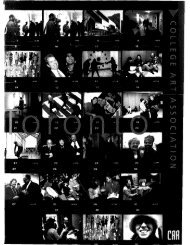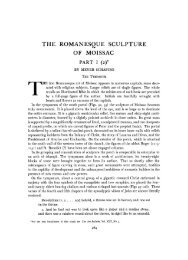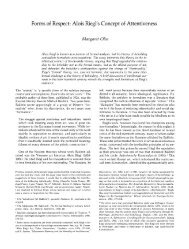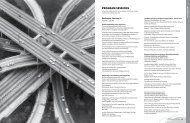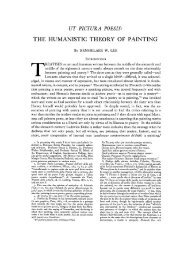Tragic Pompeii - College Art Association
Tragic Pompeii - College Art Association
Tragic Pompeii - College Art Association
Create successful ePaper yourself
Turn your PDF publications into a flip-book with our unique Google optimized e-Paper software.
230 THE ART BULLETIN JUNE 1994 VOLUME LXXVI NUMBER 2<br />
. ... .. . ...<br />
.<br />
-.........<br />
i;;;;;; i<br />
.. E .. --iii- ii:-;iiiiiiiiiiiilii~_<br />
- ;; ---;;i::--::-:--;<br />
: ii-Ak ;----';~i~~-i-;;-----;:;<br />
iiiiiiiiiiii14<br />
:-;;;;;--11T OW<br />
::;::-----;;;iiiii:14 M.i<br />
-i :;::: :::i:::-:i ::;: :::: - : -i : - : - :-:: - ::- : ":- --<br />
7 Watercolor of original mosaic floor design in tablinum. From<br />
D. Raoul-Rochette, Choix des monuments inddits. I. Maison du<br />
Poete Tragique d Pompei, Paris, 1828, pl. 19<br />
quite suggestive of such actions in their tendency to repopulate<br />
certain spaces. For example, the repeated selection of<br />
two main viewpoints in the House of the <strong>Tragic</strong> Poet<br />
corroborates new hypotheses about the social structure of the<br />
Roman house. The primary view leads from the fauces<br />
through the atrium, and then the tablinum, to the focal point<br />
of the lararium at the back of the peristyle (Figs. 5, 8-10).<br />
This "public axis," accessible to the ancient visitor and, when<br />
doors were open, visually to the passerby on the street, was<br />
extended in typical Roman fashion by an oblique alignment<br />
of broken axes; the tablinum, raised a step, lies slightly to the<br />
west of the atrium, while the peristyle, raised still another<br />
MY Ap<br />
6 Gustave Boulanger, Rehearsal of "The<br />
Flute Player" in the Atrium of the House of<br />
H.I.H. The Prince Napoleon, oil on can-<br />
vas, 1861. Versailles, Mus6e National<br />
du Chfateau, MV 5614<br />
step, shifts back to the east. The play with proportion and<br />
optical illusion in the traditional sequence of rooms continued<br />
through the actual garden, which was further extended<br />
by a trompe-l'oeil mural on the terminating wall depicting<br />
blue sky and green trees.<br />
Early tourist views also acknowledge a second axis in the<br />
house from the back door through the peristyle to the<br />
monumental triclinium (Fig. 11). A lithograph by G. Gigante<br />
of the mid-nineteenth century captures the viewpoint of an<br />
ancient diner lying in the triclinium, with visitors milling<br />
around the peristyle and a voyeur peering through the back<br />
gate. Gigante emulated the Roman habit of framing views<br />
with doors and columns, even shifting the "Sacrifice of<br />
Iphigenia" toward the lararium in place of the original<br />
garden painting.19<br />
Scholars have recently looked to this dual orientation<br />
within the Roman house for clues about social patterns of<br />
behavior.20 Already a century and a half ago, Raoul-Rochette<br />
established that the House of the <strong>Tragic</strong> Poet divides into two<br />
parts along separate axes, and that these two zones accommodated<br />
different activities (Fig. 12). His sectional views show,<br />
above, the long axis from the front door on the left through<br />
the grand reception spaces of the atrium and the tablinum to<br />
the peristyle at the far right; and below, the secondary axis<br />
from the back door through the peristyle to the large<br />
19 On the views by G. Gigante, see L. Fino, Ercolano e Pompei: Vedute<br />
neoclassiche e romantiche, Naples, 1988, 126-157. On the framing of views<br />
within the house, see H. Drerup, "Bildraum und Realraum in der<br />
r6mischen Architektur," Romische Mitteilungen, LXVI, 1959, 147-174;<br />
many of Drerup's ideas are recapitulated with diagrams by L. Bek,<br />
Towards Paradise on Earth: Modern Space Conception in Architecture. A<br />
Creation of Renaissance Humanism (Analecta Romana Instituti Danici,<br />
Supplementum IX), Odense, 1980; for an exhaustive study with reconstructions,<br />
see F. Jung, "Gebaute Bilder," Antike Kunst, xxvII, 1984, 71-122.<br />
20 Wallace-Hadrill, 55-56; idem, "The Social Spread of Roman Luxury:<br />
Sampling <strong>Pompeii</strong> and Herculaneum," Papers of the British School at<br />
Rome, LVIII, 1990, 146-192; J. Clarke, The Houses of Roman Italy, 100<br />
B.C.-A.D. 250: Ritual, Space, Decoration, Berkeley, 1991.



